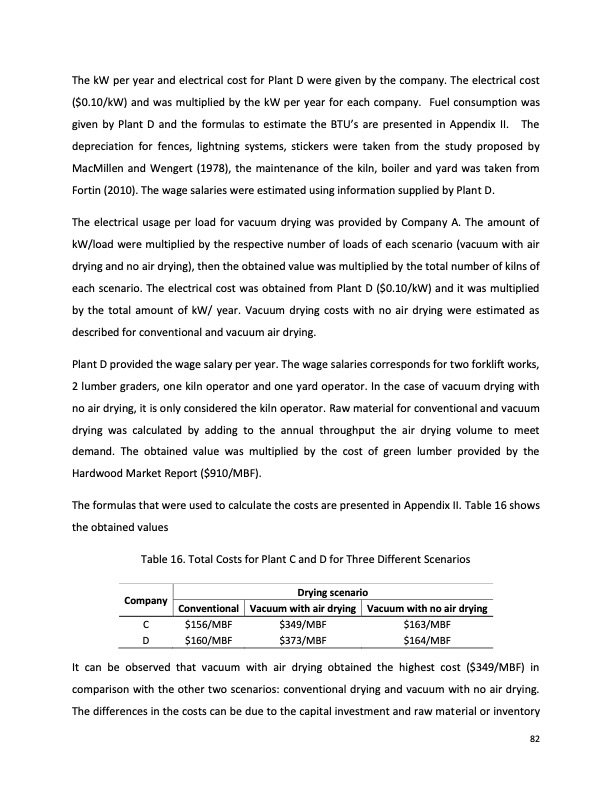
PDF Publication Title:
Text from PDF Page: 092
The kW per year and electrical cost for Plant D were given by the company. The electrical cost ($0.10/kW) and was multiplied by the kW per year for each company. Fuel consumption was given by Plant D and the formulas to estimate the BTU’s are presented in Appendix II. The depreciation for fences, lightning systems, stickers were taken from the study proposed by MacMillen and Wengert (1978), the maintenance of the kiln, boiler and yard was taken from Fortin (2010). The wage salaries were estimated using information supplied by Plant D. The electrical usage per load for vacuum drying was provided by Company A. The amount of kW/load were multiplied by the respective number of loads of each scenario (vacuum with air drying and no air drying), then the obtained value was multiplied by the total number of kilns of each scenario. The electrical cost was obtained from Plant D ($0.10/kW) and it was multiplied by the total amount of kW/ year. Vacuum drying costs with no air drying were estimated as described for conventional and vacuum air drying. Plant D provided the wage salary per year. The wage salaries corresponds for two forklift works, 2 lumber graders, one kiln operator and one yard operator. In the case of vacuum drying with no air drying, it is only considered the kiln operator. Raw material for conventional and vacuum drying was calculated by adding to the annual throughput the air drying volume to meet demand. The obtained value was multiplied by the cost of green lumber provided by the Hardwood Market Report ($910/MBF). The formulas that were used to calculate the costs are presented in Appendix II. Table 16 shows the obtained values Table 16. Total Costs for Plant C and D for Three Different Scenarios Company Drying scenario Conventional Vacuum with air drying $349/MBF $373/MBF Vacuum with no air drying $163/MBF $164/MBF C $156/MBF D $160/MBF It can be observed that vacuum with air drying obtained the highest cost ($349/MBF) in comparison with the other two scenarios: conventional drying and vacuum with no air drying. The differences in the costs can be due to the capital investment and raw material or inventory 82PDF Image | Impact of Vacuum-Drying on Efficiency of Hardwood Products

PDF Search Title:
Impact of Vacuum-Drying on Efficiency of Hardwood ProductsOriginal File Name Searched:
Brenes_Angulo_OM_T_2014.pdfDIY PDF Search: Google It | Yahoo | Bing
5,000 BF Shipping Container Lumber Dry Kiln For Quality Lumber The 5,000 BF container kiln consists of one 40 foot high-cube aluminum shipping container... More Info
Shipping Container Lumber Dry Kilns by Global Energy Global Energy designed and developed the container kiln back in 1991. The purpose is to give access to portable sawmill owners, furniture makers, and small business the value added profit of dry kiln lumber and quality hardwoods... More Info
Vacuum Kiln Conversion Kit for Lumber and Wood Dry Kilns Convert your existing conventional dry kiln into a fast drying vacuum kiln. Similar to vacuum bagging in the boat building and aircraft industry, we have come up with a proprietary process which allows you to build a very simple vacuum kiln at a fraction of the price, and without the intensive conventional metal chamber structure... More Info
Vacuum Pump Cart System for Bagging Clamping Wood Drying and more Vacuum Cart with 2HP Pump and Dual Pistons with multiple multiplex vacuum ports and liquid reservoir... More Info
Vacuum Bagging Basics Vacuum bagging is a method of clamping, which has traditionally been used in the composites industry, but can also be used for vacuum drying materials, including wood products... More Info
| CONTACT TEL: 608-238-6001 Email: greg@globalmicroturbine.com | RSS | AMP |